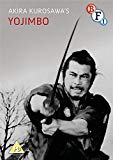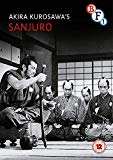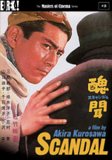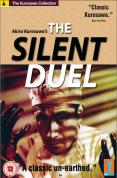![Throne Of Blood [1957]](/pictures/1003692.jpg) Throne Of Blood | DVD | (22/10/2001)
from £12.61
| Saving you £7.38 (58.52%)
| RRP
Throne Of Blood | DVD | (22/10/2001)
from £12.61
| Saving you £7.38 (58.52%)
| RRP A champion of illumination and experimental shading, Kurosawa brings his unerring eye for indelible images to Shakespeare in this 1957 adaptation of Macbeth. By changing the locale from Birnam Wood to 16th-century Japan, Kurosawa makes an oddball argument for the trans-historicity of Shakespeare's narrative; and indeed, stripped to the bare mechanics of the plot, the tale of cut-throat ambition rewarded (and thwarted) feels infinitely adaptable. What's lost in the translation, of course, is the force and beauty of the language--much of the script of Throne of Blood is maddeningly repetitive or superfluous--but striking visual images (including the surreal Cobweb Forest and some extremely artful gore) replace the sublime poetry. Toshiro Mifune is theatrically intense as Washizu, the samurai fated to betray his friend and master in exchange for the prestige of nobility; he portrays the ill-fated warrior with a passion bordering on violence, and a barely concealed conviviality. Somewhat less successful is Isuzu Yamada as Washizu's scheming wife; her poise and creepy impassivity, chilling at first, soon grows tedious. Kurosawa himself is the star of the show, though, and his masterful use of black-and-white contrast--not to mention his steady, dramatic hand with a battle scene--keeps the proceedings thrilling. A must-see for fans of Japanese cinema, as well as all you devotees of samurai weapons and armour. --Miles Bethany
![Kagemusha [Blu-ray] [1980]](/pictures/1125109.jpg) Kagemusha | Blu Ray | (17/03/2014)
from £N/A
| Saving you £N/A (N/A%)
| RRP
Kagemusha | Blu Ray | (17/03/2014)
from £N/A
| Saving you £N/A (N/A%)
| RRP The 1970s were difficult years for the great Japanese director Akira Kurosawa. Having been unable to secure full Japanese backing for his epic project Kagemusha, the 70-year-old master found American support from George Lucas and Francis Ford Coppola, who served as co-executive producers (through 20th Century Fox) for this magnificent 1980 production--to that date the most expensive film in Japanese history. Set in the late-16th century, Kagemusha centres on the Takeda clan, one of three warlord clans battling for control of Japan at the end of the feudal period. When their leader Lord Shingen (Tatsuya Nakadai) is mortally wounded in battle, he orders that his death be kept secret and that his "kagemusha"--or "shadow warrior"--take his place for a period of three years to prevent clan disruption and enemy takeover. The identical double is a petty thief (also played by Nakadai) spared from execution due to his uncanny resemblance to Lord Shingen--but his true identity cannot prevent the tides of fate from rising over the Takeda clan in a climactic scene of battlefield devastation. Through stunning visuals and meticulous attention to every physical and stylistic detail, Kurosawa made a film that restored his status as Japan's greatest filmmaker, and the success of Kagemusha enabled the director to make his 1985 masterpiece, Ran. --Jeff Shannon
![Drunken Angel [1948]](/pictures/1010992.jpg) Drunken Angel | DVD | (25/07/2005)
from £13.99
| Saving you £6.00 (42.89%)
| RRP
Drunken Angel | DVD | (25/07/2005)
from £13.99
| Saving you £6.00 (42.89%)
| RRP Post-war Japan anatomised in the combative relationship between an alcoholic doctor (Takeshi Shimura) and his patient (Toshiro Mifune) a wounded young gangster. This is the film that was considered to be Kurosawa's breakthrough movie illuminating themes that would go on to dominate his succeeding work. 'Drunken Angel' also marked his first - of many - collaborations with Toshiro Mifune here playing the tubercular Yakuza hoodlum.
 Rashomon (DVD) | DVD | (21/09/2015)
from £18.75
| Saving you £1.24 (6.61%)
| RRP
Rashomon (DVD) | DVD | (21/09/2015)
from £18.75
| Saving you £1.24 (6.61%)
| RRP This 1950 film by Akira Kurosawa is more than a classic: it's a cinematic archetype that has served as a template for many a film since. (Rashomon's most direct influence was on a Western remake, The Outrage, starring Paul Newman and directed by Martin Ritt.) In essence, the facts surrounding a rape and murder are told from four different and contradictory points of view, suggesting the nature of truth is something less than absolute. The cast, headed by Kurosawa's favourite actor, Toshiro Mifune, is superb. --Tom Keogh
![Early Kurosawa - Collection [DVD Boxset]](/pictures/1106252.jpg) Early Kurosawa - Collection | DVD | (28/03/2011)
from £34.13
| Saving you £8.12 (24.70%)
| RRP
Early Kurosawa - Collection | DVD | (28/03/2011)
from £34.13
| Saving you £8.12 (24.70%)
| RRP This collection features six early films from master Japanese filmmaker Akira Kurosawa; the 1943 Sanshiro Sugata Kurosawa's debut film follows a judo student's difficult but compelling spiritual journey. Its sequel Sanshiro Sugata: Part Two (1945) continues the tale of Sanshiro and his quest to become a martial arts master. 1944's Ichiban Utsukushiku (The Most Beautiful) is a propagandistic wartime drama about female volunteers employed at an optics factory. 1945's Tora No O Wo Fumu Otokotachi (They Who Step On The Tiger's Tail) is a kabuki-inspired tale about a lord who disguises himself as a monk to get past a seemingly impenetrable roadblock. 1946's Waga Seishun Ni Kuinashi (No Regrets For Our Youth) is a touching tale about a young girl from a privileged background who is exposed to Japan's peasant farmers. And finally 1947's Subarashiki Nichiyobi (One Wonderful Sunday) follows the activities of a couple who are struggling with the poor postwar economic climate of the country.
 Yojimbo (DVD) | DVD | (12/06/2017)
from £15.85
| Saving you £N/A (N/A%)
| RRP
Yojimbo (DVD) | DVD | (12/06/2017)
from £15.85
| Saving you £N/A (N/A%)
| RRP This semi-comic 1961 film by legendary director Akira Kurosawa (Rashomon, Ran) was inspired by the American Western genre. Kurosawa mainstay Toshirô Mifune (Seven Samurai) is cast as a drifting samurai for hire who plays both ends against the middle with two warring factions, surviving on his wits and his ability to outrun his own bad luck. Eventually the samurai seeks to eliminate both sides for his own gain and to define his own sense of honour. Yojimbo is striking for its unorthodox treatment of violence and morality, reserving judgment on the actions of its main character and instead presenting an entertaining tale with humour and much visual excitement. One of the inspirations for the "spaghetti westerns" of director Sergio Leone and later surfacing as a remake as Last Man Standing with Bruce Willis, this film offers insight into a director who influenced American films even as he was influenced by them. --Robert Lane, Amazon.com
 Sanjuro (DVD) | DVD | (26/06/2017)
from £12.49
| Saving you £N/A (N/A%)
| RRP
Sanjuro (DVD) | DVD | (26/06/2017)
from £12.49
| Saving you £N/A (N/A%)
| RRP A film by Akira Kurosawa In response to the huge critical and commercial success of Yojimbo (1961), Kurosawa and Mifune re-teamed a year later to make Sanjuro, a hilarious comedy of manners altogether more light-hearted than its predecessor. The story has Sanjuro (Mifune) running lazy rings around nine naïve and clean-cut samurai and two genteel ladies, whilst also cleaning up a spot of corruption in local government. Whilst Kurosawa plays most of it for laughs, expertly parodying the conventions of Japanese period action films, he stages a startling switch of mood with an intense finale which may well be the briefest, and most breathtaking duel in all cinema. Special Features: Digitally remastered in High Definition Introduction to Sanjuro by filmmaker Alex Cox (2003, 5 mins) Interview with filmmaker Alex Cox (2003, 9 mins): the director discusses the life and work of Akira Kurosawa Original Japanese theatrical trailer Essay by film historian and critic Philip Kemp Japan | 1962 | black and white | Japanese language, with optional English subtitles | 92 minutes | DVD9 | original aspect ratio 2.35:1 | PCM mono audio (320kbps) | Cert 12 | region 2
![High And Low [1963]](/pictures/1011276.jpg) High And Low | DVD | (28/03/2005)
from £18.75
| Saving you £1.24 (6.61%)
| RRP
High And Low | DVD | (28/03/2005)
from £18.75
| Saving you £1.24 (6.61%)
| RRP Kurosawa drew on the thriller 'King's Ransom' by Ed McBain (aka Evan Hunter) for this contemporary study of the inequalities and hierarchical rigidity of modern Japan. In the first half of the film set in a single room an industrialist agonises on whether to pay the huge ransom demanded by kidnappers who have mistakenly snatched his chauffeur's son instead of his own. The second half of the film shot in a frenzied restless style on sleazy urban locations concentrates on the polic
![Ran [1985]](/pictures/1049530.jpg) Ran | DVD | (20/11/2006)
from £N/A
| Saving you £N/A (N/A%)
| RRP
Ran | DVD | (20/11/2006)
from £N/A
| Saving you £N/A (N/A%)
| RRP Akira Kurosawa's brilliantly conceived retelling of Shakespeare's 'King Lear' magically mixes Japanese history Shakespeare's plot and Kurosawa's own feelings about loyalty in this epic masterpiece. Set in 16th century Japan an aging ruler Lord Hidetora (Tatsuya Nakadai) announces his intention to divide his land equally among his three sons. This decision to step down unleashes a power struggle between the three when Hidetora falls prey to the false flattery bestowed upon him by the two older sons and banishes the youngest when he speaks the truth. The ruthless betrayal ultimately drives Hidetora insane destroying his entire family and kingdom. Deep human emotion and outstanding acting combine to create one of the most acclaimed foreign films of all time.
![Stray Dog [1949]](/pictures/1006129.jpg) Stray Dog | DVD | (25/03/2002)
from £11.99
| Saving you £8.00 (66.72%)
| RRP
Stray Dog | DVD | (25/03/2002)
from £11.99
| Saving you £8.00 (66.72%)
| RRP Akira Kurosawa's Stray Dog is a masterful mix of film noir and police thriller set on the sweltering mean streets of Occupied Tokyo. When rookie detective Murakami (Toshiro Mifune) has his pistol stolen from his pocket while on a bus his frantic attempts to track down the thief lead him to an illegal weapons market in the Tokyo underworld. But the gun has already passed from the pickpocket to a young gangster and Murakami's gun is identified as the weapon in the shooting of a woman
![Kagemusha [DVD]](/pictures/1120285.jpg) Kagemusha | DVD | (18/02/2013)
from £N/A
| Saving you £N/A (N/A%)
| RRP
Kagemusha | DVD | (18/02/2013)
from £N/A
| Saving you £N/A (N/A%)
| RRP A petty thief with an utter resemblance to a samurai warlord is hired as the lord's double. When the warlord later dies the thief is forced to take up arms in his place.
![Hidden Fortress [1958]](/pictures/1006132.jpg) Hidden Fortress | DVD | (25/03/2002)
from £19.99
| Saving you £N/A (N/A%)
| RRP
Hidden Fortress | DVD | (25/03/2002)
from £19.99
| Saving you £N/A (N/A%)
| RRP A story of rival clans hidden gold and a princess in distress The Hidden Fortress is a thrilling mix of fairy story and samurai action movie. It was Kurosawa's first film shot in the widescreen process of Tohoscope and he exploited this to the full in the film's rich variety of landscape locations including the slopes of Mount Fuji. The Hidden Fortress became Kurosawa's biggest box-office hit to date and won several awards including the Golden Bear at the 1959 Berlin Film Fest
![Sanjuro [1962]](/pictures/1002186.jpg) Sanjuro | DVD | (06/10/2003)
from £12.99
| Saving you £7.00 (53.89%)
| RRP
Sanjuro | DVD | (06/10/2003)
from £12.99
| Saving you £7.00 (53.89%)
| RRP Sequel to Kurosawa's own 'Yojimbo' in which the crafty samurai helps a young man and his fellow clansmen save his uncle who has been framed and imprisoned by a corrupt superintendent...
![Rhapsody In August [1993]](/pictures/1006230.jpg) Rhapsody In August | DVD | (14/04/2000)
from £15.93
| Saving you £0.06 (0.40%)
| RRP
Rhapsody In August | DVD | (14/04/2000)
from £15.93
| Saving you £0.06 (0.40%)
| RRP Japanese grand master Akira Kurosawa's eloquent examination of the nuclear holocaust in Nagasaki as seen though the eyes of a survivor and her four grandchildren 44 years after the event. The grandmother recalls the history of her family and Japanese society. As she searches for an understanding of the past she falls into despair over the loss of her husband in the blast as its anniversary draws near.
![The Bad Sleep Well [1960]](/pictures/1000197.jpg) The Bad Sleep Well | DVD | (25/07/2005)
from £13.49
| Saving you £6.50 (48.18%)
| RRP
The Bad Sleep Well | DVD | (25/07/2005)
from £13.49
| Saving you £6.50 (48.18%)
| RRP A tense re-working of Hamlet (adapted from a novel by Ed McBain) is a biting expos of the corruption and politics of greed at the heart of Japanese business. Beautifully photographed in ravishing black and white Tohoscope this is original Japanese version never before released in Europe. A young man marries the boss's daughter as part of a scheme to take revenge on the influential businessman who forced his father to commit suicide. Leisurely paced bitterly ironic the film emplo
![Red Beard [1965]](/pictures/1005600.jpg) Red Beard | DVD | (06/10/2003)
from £18.38
| Saving you £3.37 (20.28%)
| RRP
Red Beard | DVD | (06/10/2003)
from £18.38
| Saving you £3.37 (20.28%)
| RRP The last and most ambitious of Akira Kurosawa's collaborations with Toshiro Mifune Red Beard marked the end of one of the most remarkable actor-director relationships in the history of cinema. Toshiro Mifune plays a commanding but humane doctor in a rural clinic in late 19th-century Japan. An idle and socially ambitious intern (Yuzo Kayama) arrives at the clinic and discovers the meaning of responsibility first to oneself and then to others. This intimate epic - a
![Rashomon [1950]](/pictures/1006201.jpg) Rashomon | DVD | (22/10/2001)
from £N/A
| Saving you £N/A (N/A%)
| RRP
Rashomon | DVD | (22/10/2001)
from £N/A
| Saving you £N/A (N/A%)
| RRP This 1950 film by Akira Kurosawa is more than a classic: it's a cinematic archetype that has served as a template for many a film since. (Rashomon's most direct influence was on a Western remake, The Outrage, starring Paul Newman and directed by Martin Ritt.) In essence, the facts surrounding a rape and murder are told from four different and contradictory points of view, suggesting the nature of truth is something less than absolute. The cast, headed by Kurosawa's favourite actor, Toshiro Mifune, is superb. --Tom Keogh
 Scandal | DVD | (14/11/2005)
from £5.54
| Saving you £14.45 (72.30%)
| RRP
Scandal | DVD | (14/11/2005)
from £5.54
| Saving you £14.45 (72.30%)
| RRP On holiday in the snow-covered mountains young painter Ichiro Aoye (Toshiro Mifune) has a chance meeting with the popular singer Miyako Saijo (Shirley Yamaguchi). After giving her a ride back to the hotel where they are both staying Ichiro is photographed with Miyako by paparazzi. A magazine creates an expos of their 'secret romance' based around this photograph and the brooding Ichiro ignites a bitter and dirty libel case in order to restore their honour... Akira Kurosawa's
 The Silent Duel | DVD | (22/10/2007)
from £N/A
| Saving you £N/A (N/A%)
| RRP
The Silent Duel | DVD | (22/10/2007)
from £N/A
| Saving you £N/A (N/A%)
| RRP This 1949 rarely-seen masterpiece from legendary director Akira Kurosawa has never-before been released in the UK. During a life-saving operation young army surgeon Fujisaki (Mifune) contracts syphilis from a patient a disease virtually incurable in 1940's Japan and is forced to abandon his own true love. Based on an acclaimed play by Kazuo Nikuta The Silent Duel marked the second of numerous collaborations between the director and leading man Toshiro Mifune.
![Seven Samuari (Blu-ray Steelbook) [DVD]](/pictures/1126302.jpg) Seven Samuari (Blu-ray Steelbook) | Blu Ray | (21/04/2014)
from £21.98
| Saving you £-1.99 (-10.00%)
| RRP
Seven Samuari (Blu-ray Steelbook) | Blu Ray | (21/04/2014)
from £21.98
| Saving you £-1.99 (-10.00%)
| RRP Limited Edition Steelbook - includes debossed title treatment. In sixteenth-century Japan a poor village is raided every year by a group of bandits until, driven to the brink of starvation, the villagers decide to hire professional warriors to protect them. With only three meagre meals a day to offer as payment, their quest seems an impossible one. Kurosawa's masterpiece testifies to his admiration for the classic Western, and in 1960 John Sturges repaid the compliments by remaking Seven Samurai as The Magnificent Seven.

Please wait. Loading...
This site uses cookies.
More details in our privacy policy